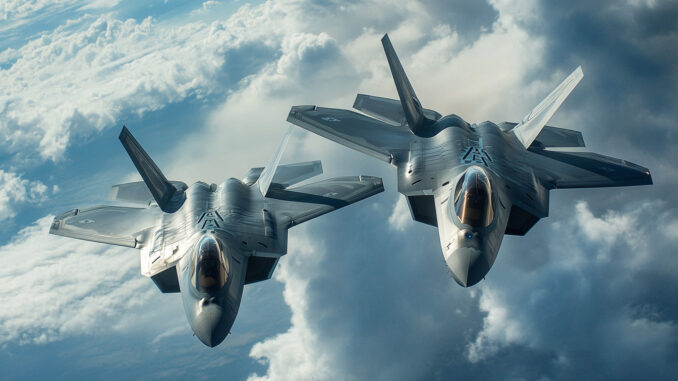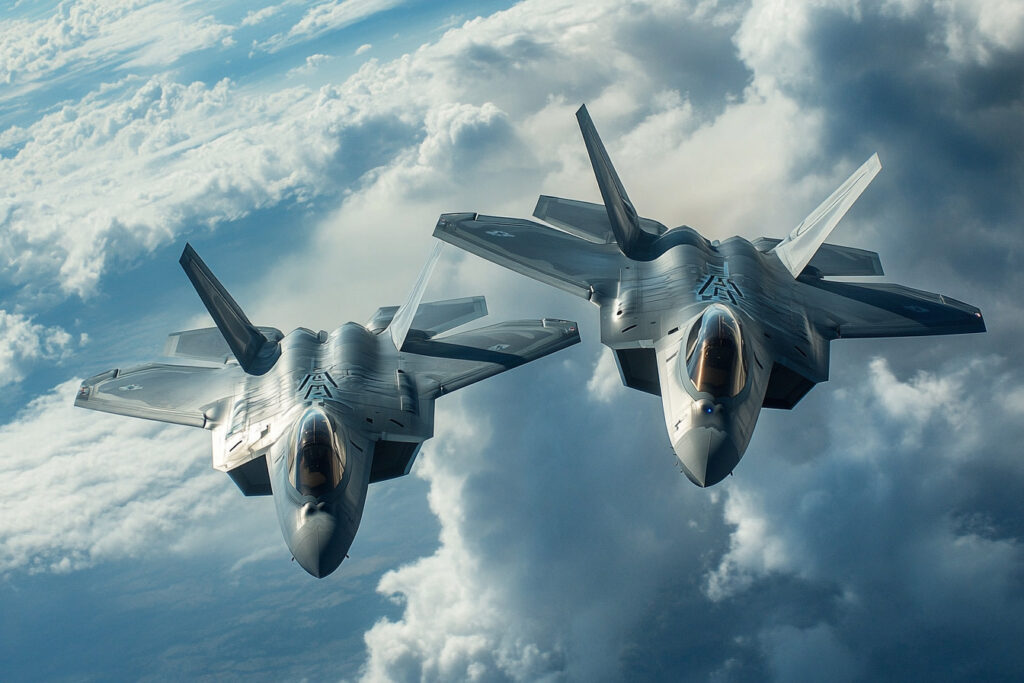
The Mako hypersonic missile, developed by Lockheed Martin, enhances the capabilities of the F-22 and F-35. Strategic analysis and military implications.
Lockheed Martin’s Mako hypersonic missile represents a significant advance in the global competition for hypersonic weapons. Capable of exceeding Mach 5, this missile can be deployed from a variety of US fighter aircraft, including the F-35, F-22, and F/A-18. Thanks to its in-flight manoeuvring capability and versatility, the Mako can target land and sea targets, making it a crucial tool in countering China’s anti-access/area denial (A2/AD) strategies. Using digital engineering and additive manufacturing, Lockheed Martin is aiming for efficient mass production, strengthening US power projection in the Indo-Pacific region.
Mako hypersonic missile: technical characteristics and operational capabilities
The Mako hypersonic missile, designed by Lockheed Martin, is distinguished by its ability to reach speeds in excess of Mach 5 (more than 6,174 km/h). This extraordinary speed, which far exceeds that of conventional missiles, gives the Mako a considerable advantage on the battlefield by significantly reducing the reaction time of opposing defence systems. Another crucial technical aspect of the Mako is its ability to manoeuvre in flight, enabling it to evade anti-missile defence systems, making it an extremely difficult weapon to intercept.
The Mako’s compact dimensions enable it to be carried in the internal weapons bays of fifth-generation fighter aircraft such as the F-35 Lightning II and the F-22 Raptor. This compatibility with multiple air platforms, including the F/A-18 Super Hornet, offers strategic flexibility to the US armed forces, allowing them to deploy the Mako from different bases and in a variety of tactical configurations.
The Mako’s ability to adapt to different missions, whether land or sea strikes, makes it an essential force multiplier. For example, in the context of a conflict in the Pacific, the Mako could be used to neutralise long-range Chinese anti-ship systems, providing an opening for US naval operations. This versatility is enhanced by the possibility of carrying out strikes against high-value-added targets, such as command centres or critical infrastructures, thereby disrupting the enemy’s command and control capabilities.
Production and industrial integration: digital engineering and additive manufacturing
Production of the Mako hypersonic missile is based on cutting-edge technologies such as digital engineering and additive manufacturing (3D printing). These technologies help to reduce production costs while increasing the efficiency and speed of the manufacturing process. Digital engineering, which involves digitally modelling each component of the missile before it is manufactured, makes it possible to optimise the design and anticipate and resolve potential problems before the physical production phase. This not only reduces lead times, but also improves the quality of the final product.
Additive manufacturing, on the other hand, enables complex parts to be produced with a precision and speed unmatched by traditional methods. This method also offers greater flexibility in terms of design, enabling lighter and stronger parts to be created. For example, a study by the University of Seville showed that using additive manufacturing in the aerospace industry can reduce the weight of components by up to 60%, while increasing their structural strength by 30%. For the Mako, this means increased range and manoeuvrability, while reducing fuel consumption.
In addition, the ability to mass-produce missiles like the Mako is essential to guarantee the availability of these weapons in the event of prolonged conflict. The use of these modern technologies allows Lockheed Martin to envisage large-scale production, thereby meeting the US Department of Defense’s need to maintain a sufficient stockpile of hypersonic weapons. This is particularly crucial in the context of a possible confrontation with powers such as China, where the speed of production and deployment of the weapons could determine the outcome of the conflict.

The strategic context: countering China’s A2/AD strategy
China has developed an anti-access/area denial (A2/AD) strategy to limit the ability of US forces to intervene in strategic regions such as the South China Sea, the East China Sea and the Taiwan Strait. This strategy is based on the use of ballistic missiles, anti-ship systems and other technologies designed to prevent enemy forces from gaining access to certain strategic areas. This approach, dubbed ‘Assassin’s Mace’ in China, represents a major challenge for the US armed forces, who face increased risks when operating in these areas.
The Mako hypersonic missile offers a potential response to this threat. Thanks to its ability to evade defence systems and strike targets at long range, the Mako would enable US forces to neutralise Chinese A2/AD systems before they could be used effectively. For example, in the event of a conflict, the Mako could be used to strike DF-21D anti-ship ballistic missile batteries, often referred to as ‘carrier killers’, before they could be used against US naval forces.
The Mako’s ability to threaten Chinese assets at sea and on land could also force China to review its strategy, by limiting its freedom of movement in the region. Indeed, the ability of US forces to strike quickly and accurately at strategic targets would reduce the effectiveness of Chinese operations, giving US forces an advantage.
The challenge of mass production and competitiveness
Despite the technological advances represented by the Mako hypersonic missile, the issue of mass production remains a major challenge for the United States. The country has been criticised for its slow arms production, a problem compounded by growing tensions with powers such as China and Russia. Insufficient production could limit the US’s ability to maintain a dominant position in the Indo-Pacific region, especially if a protracted conflict were to arise.
Lockheed Martin has taken steps to address this issue by integrating advanced technologies into its production process, but challenges remain. For example, while additive manufacturing offers significant benefits, it also requires considerable investment in infrastructure and employee training. According to a Deloitte report, fully integrating additive manufacturing into production processes can require high initial investments, ranging from €10 million to €50 million, depending on the scale and complexity of the systems to be produced.
Furthermore, the competitiveness of the Mako will depend on its ability to be produced at a reasonable cost. Currently, the unit cost of hypersonic missiles is high, partly due to the specialist materials and technologies required to manufacture them. For example, the production cost of a typical hypersonic missile can vary between €20 and €30 million, depending on the specifications and quantities produced. For the Mako to be a viable long-term option, Lockheed Martin will not only need to optimise its production to reduce these costs, but also ensure that the missile remains competitive with the technological developments of its rivals.
Strategic implications for the future of hypersonic weapons
The introduction of the Mako hypersonic missile into the US arsenal marks an important step in the evolution of US military capabilities. However, this technological advance also raises questions about the future of hypersonic warfare and its impact on global strategic balances. At a time when the United States is striving to catch up in this area, the proliferation of hypersonic weapons could lead to a new arms race, exacerbating tensions between the major powers.
In addition, the development of hypersonic weapons such as the Mako poses arms control challenges. Current non-proliferation and arms control regimes, such as the Intermediate-range Nuclear Forces (INF) Treaty, do not explicitly cover hypersonic weapons. This gap could encourage other nations to develop their own hypersonic systems, increasing the risk of uncontrolled escalation.
Finally, the integration of the Mako into the US armed forces will also require an adaptation of military doctrines and strategies. US forces will have to develop new tactics to take full advantage of the capabilities offered by hypersonic weapons, while preparing to counter adversaries who could also deploy such weapons.
War Wings Daily is an independant magazine.